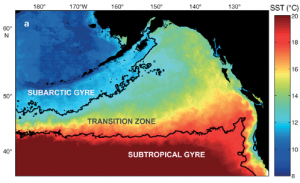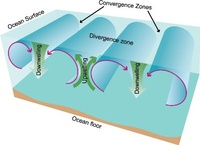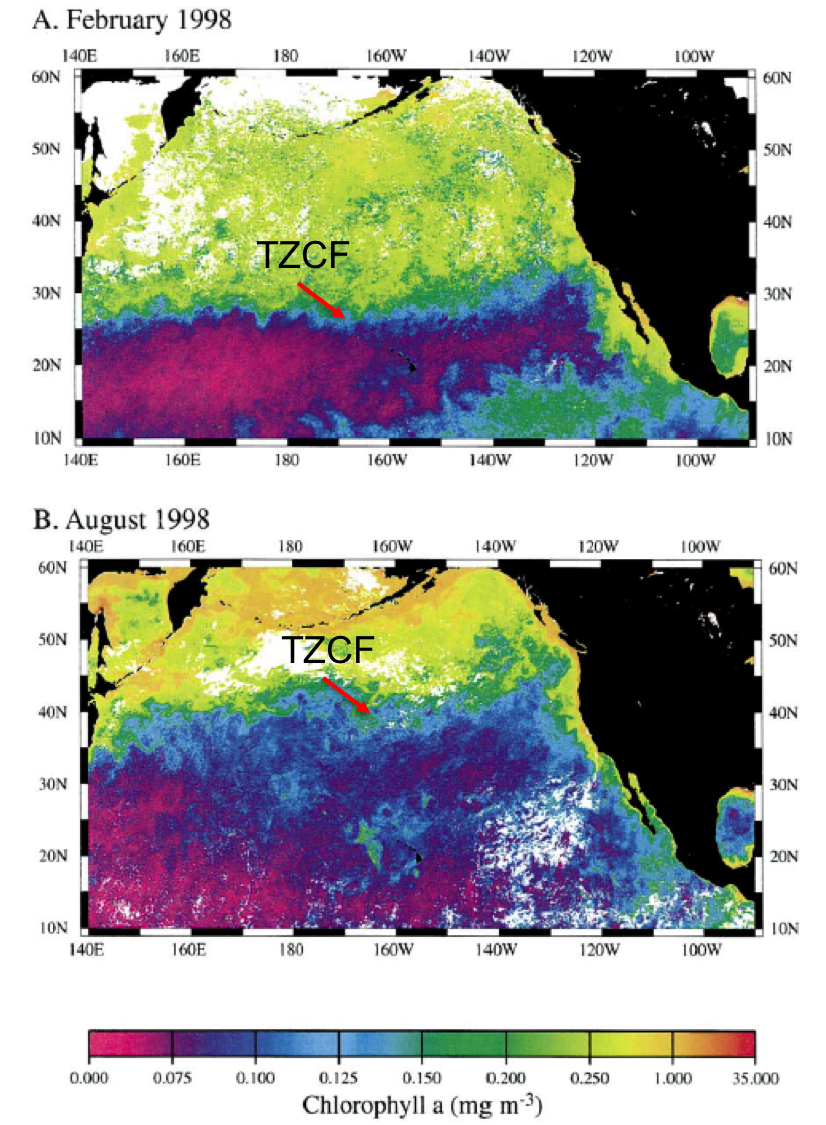The North Pacific Transition Zone and Transition Zone Chlorophyll Front
The North Pacific Transition Zone
 The region of the ocean where the North Pacific subtropical and subpolar gyres meet is known as the North Pacific Transition Zone (NPTZ). (See image to the right. Source: Simmons et al. 2010. Climate-scale hydrographic features related to foraging success in a capital breeder, the northern elephant seal Mirounga angustirostris).
The region of the ocean where the North Pacific subtropical and subpolar gyres meet is known as the North Pacific Transition Zone (NPTZ). (See image to the right. Source: Simmons et al. 2010. Climate-scale hydrographic features related to foraging success in a capital breeder, the northern elephant seal Mirounga angustirostris).
- The North Pacific subtropical gyre contains warm, nutrient poor water originating from the equatorial region, while the subpolar gyre contains cool, nutrient-rich water originating from polar latitudes. Because of differences in water temperature and other properties, such as salinity (the concentration of salt in water), the water masses are also different densities.
- Downwelling, or the sinking of water to the deep ocean, occurs where water masses are converging,
 or being pushed together along their boundary. Downwelling occurs where the North Pacific subtropical and subpolar gyres meet. (See image to the right. Source: AE Neiblas, CSIRO, accessed at: https://www.e-education.psu.edu/earth103/node/706)
or being pushed together along their boundary. Downwelling occurs where the North Pacific subtropical and subpolar gyres meet. (See image to the right. Source: AE Neiblas, CSIRO, accessed at: https://www.e-education.psu.edu/earth103/node/706)
- Organisms that are buoyant and those which can maintain their vertical position in the water column will remain near the surface where downwelling is occurring. This causes the accumulation of organisms along the margins of converging water masses (Polovina 2001).
- Currents that form the boundaries of each gyre can interact to create “mesoscale features” such as eddies and SST fronts. Eddies are areas of swirling ocean water at the ocean’s surface that are formed where water masses of different densities interact. SST fronts are areas of rapid change in SST, which also occur where two water masses meet. These mesoscale features persist on the order of days to months, and have been found to concentrate biological activity.
Transition Zone Chlorophyll Front
- The Transition Zone Chlorophyll Front (TZCF) is an area of rapidly changing chlorophyll concentration that spans the east-west extent of the North Pacific. Temperature and nutrients also change rapidly in this frontal zone (Polovina 2001).
- This feature is always present in the North Pacific, but it moves seasonally northward and southward within the North Pacific Transition Zone between a range of 30°N to 45°N over a distance of about 1000 km (Polovina 2001).
- In the fall and winter, the TZCF moves southward. During this time, strong winds are hypothesized to move nutrients across the boundary between gyres, causing an accumulation of nutrients in the northern part of the North Pacific subtropical gyre (Ayers and Lozier 2010).
- In the spring, the winds lessen and nutrient transport southward is reduced. This causes the position of the TZCF to move northward, reaching it’s most northerly position in the summer (Ayers and Lozier 2010).
Source: Polovina 2001
- The same mechanisms that are believed to cause shifts in the TZCF are also hypothesized to concentrate other organisms such as zooplankton and fish in the TZCF (Ayers and Lozier 2010).

